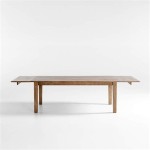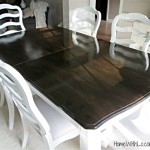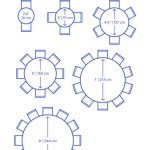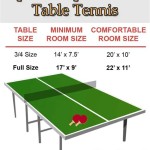Standard Size of a 6-Seater Rectangular Dining Table
The dining table stands as a central piece of furniture in many homes, acting as a gathering place for meals, conversations, and sometimes even work or hobbies. Choosing the right size and shape of a dining table is crucial for ensuring comfortable seating, adequate space for food and serving dishes, and overall aesthetic appeal within the dining area. For many families and individuals who frequently entertain, a 6-seater rectangular dining table represents a practical and versatile option. Understanding the standard dimensions of this type of table is essential for making an informed purchase and optimizing the available space.
The "standard size" of any piece of furniture is not always a fixed, universally agreed-upon measurement. There is a degree of variability depending on the manufacturer, the style of the table, and even regional preferences. However, we can identify a range of dimensions that are commonly considered “standard” for a 6-seater rectangular dining table. These guidelines help to ensure ergonomic comfort and functionality.
Generally, a rectangular dining table designed to comfortably seat six people typically falls within a specific length and width range. The length is the primary factor determining how many people can be seated, while the width influences the amount of space available for place settings and serving dishes. Height also plays a role, affecting overall comfort and ease of use.
The subsequent sections delve into the typical dimensions associated with a 6-seater rectangular dining table, covering length, width, and height. We will also explore factors that can influence these dimensions and offer guidance on choosing the right size for a specific dining space.
Typical Length of a 6-Seater Rectangular Dining Table
The length of a 6-seater rectangular dining table is the most critical measurement for determining seating capacity. A common rule of thumb is that each person requires approximately 24 inches of width to dine comfortably. This allowance allows for adequate personal space and prevents elbows from bumping during a meal. Given this guideline, a table intended to seat six people should ideally be at least 72 inches (6 feet) long.
However, the "standard" length often falls between 60 inches and 80 inches. The lower end of this range (60 inches to 66 inches) may feel slightly cramped, especially if the chairs have arms. A length closer to 72 inches or 78 inches is generally considered more comfortable and allows for a bit more elbow room. Tables at the longer end of the spectrum, approaching 80 inches, offer the most generous seating and are well-suited for individuals who frequently host dinner parties.
It is essential to consider the style of the table when evaluating its length. A trestle table, for example, might require a longer length than a pedestal table to accommodate the base structure without interfering with legroom. Similarly, a table with thick or decorative legs may reduce the usable seating space, necessitating a slightly longer table to achieve the desired seating capacity. When considering a dining table, be sure to physically measure the dimensions of the table including any overhang on the ends that may not be easily usable space.
Typical Width of a 6-Seater Rectangular Dining Table
The width of a 6-seater rectangular dining table determines the amount of space available for placing dishes, serving platters, and decorative centerpieces. A narrower table may feel cramped, while an excessively wide table can make conversation across the table difficult.
The standard width for a 6-seater rectangular dining table generally falls between 36 inches and 48 inches. A width of 36 inches is the minimum acceptable width to allow for comfortably placing place settings opposite each other. However, it may not leave much room for shared serving dishes. A width of 42 inches to 48 inches provides a more generous surface area, allowing for centerpieces, serving dishes and leaving enough space for drinks, appetizer plates and other dining essentials.
When selecting a table width, consider the typical dining style. For formal dinners with multiple courses and elaborate serving arrangements, a wider table is preferable. For more casual meals with simpler settings, a narrower table may suffice. Also, consider the dimensions of the chairs being used. Armchairs, in particular, require more space and may necessitate a wider table to prevent overcrowding. The space needed for placing drinks safely away from elbows and food is also essential. An unstable table that moves easily or has space enough for things to be knocked over should be avoided.
Standard Height of a Dining Table
While length and width are important for seating and surface area, the height of the dining table affects comfort and ergonomics. The standard height for a dining table, including a 6-seater rectangular table, is typically between 28 inches and 30 inches. This measurement refers to the distance from the floor to the top of the table surface.
This height is generally considered comfortable for most adults, allowing them to sit with their legs comfortably under the table and without having to hunch over to reach their plates. The standard chair height is usually 18 inches, providing approximately 10-12 inches of space between the seat and the table surface. This allows for comfortable legroom and sufficient space for movement.
However, individual preferences and physical needs can influence the optimal table height. Some individuals may prefer a slightly higher or lower table, depending on their height and seating posture. When selecting a dining table, it is always advisable to sit at the table and assess its comfort level. If possible, bring your preferred chairs to ensure a proper fit. A table of non-standard height may require custom-made chairs to provide an ergonomic dining experience. Another consideration is the age and physical limitations of the users as this also may dictate alterations to the standard height and table ergonomics.
Beyond the core dimensions of length, width, and height, other factors contribute to the overall suitability of a 6-seater rectangular dining table. These include the shape of the table's edges, the material used in its construction, and the style of its base.
The shape of the table edges can impact comfort and safety. Sharp, square edges can be uncomfortable to lean against and pose a potential hazard, especially for young children. Rounded or beveled edges offer a softer, more forgiving surface. Similarly a table with an overhang too distant from the table's legs will make for poor legroom and reduced access comfort.
The material of the table affects its durability, aesthetic appeal, and maintenance requirements. Solid wood tables are known for their strength and longevity, but they can be expensive and require proper care. Veneer tables offer a more affordable option, but they may be more susceptible to damage. Glass-topped tables create a modern, airy look, but they can be prone to scratches and fingerprints. The type and quality of material should always be taken into consideration when purchasing a dining table.
The style of the table base influences its stability and legroom. A pedestal base provides ample legroom, but it may not be as stable as a four-legged table. A trestle base offers a combination of stability and legroom, but it can sometimes interfere with chair placement. Be aware of the way the legs are positioned and the way it impedes available legroom.
Choosing the right size of a 6-seater rectangular dining table involves a careful consideration of the available space, the dining style, and the individual needs of the users. By understanding the standard dimensions and the factors that can influence them, it is possible to select a table that is both functional and aesthetically pleasing, creating a comfortable and inviting dining environment.
What Is The Comfort Dining Table Size Quora

Odra Solid Wood Six Seater Dining Set Tables Fabuliv

What Is The Standard Size Of A 6 Seater Dining Table Fabuliv Blogs 2024

What Size Is A 6 Seater Dining Table Meubilair

6 Seater Dining Table Dimensions Furdir Round Room Sizes

Revit Family Rectangular Dining Tables Post Digital Architecture

Dining Table Size Shape Seating Capacity Guide Glassdomain Blogglassdomain Blog

The Dining Room Table Size Guide Ideal Sizes For 4 6 And 8 Seater Tables

How To Calculate The Best Dining Table Size For Your Room

Standard Dining Table Dimensions The Size Guide








